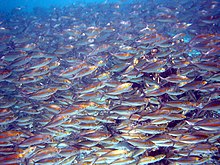Goldband fusilier
| Goldband fusilier | |
|---|---|
 |
|
| School of goldband fusiliers in Papua New Guinea | |
| Scientific classification | |
| Kingdom: | Animalia |
| Phylum: | Chordata |
| Class: | Actinopterygii |
| Order: | Perciformes |
| Family: | Caesionidae |
| Genus: | Pterocaesio |
| Species: | P. chrysozona |
| Binomial name | |
|
Pterocaesio chrysozona (G. Cuvier, 1830) |
|
The goldband fusilier (Pterocaesio chrysozona) is a fusilier of the genus Pterocaesio. It is also known as the blacktipped fusilier. This is a tropical reef forage fish found between latitudes 30°N and 27°S and longitudes 40°E to 157°E. It is widespread around reefs in the Red Sea, the west Pacific Ocean, and along east Africa, west India, and east Australia.
Goldband fusiliers grow to 21 cm. They are a non-migratory fish, found during the day moving in schools at depths between 5 and 35 metres among coral reefs, seagrass, along outer reef slopes and around pinnacles in deep lagoons. At night they shelter inside the reef. They are not suitable for home aquaria, since they require unrestricted space.
They have a yellow stripe on each side, parallel to and one or two scales below the lateral line. Their back (dorsal area) is light blue to brown and their belly (ventral area) is white to pink.
They have high resilience, with a minimum population doubling time under 15 months. They are filter feeders, feeding midwater on aggregations of zooplankton. In turn, they are preyed on by coral trout. Oviparous, they lay many small eggs which float pelagically in the water.
Goldband fusilier play a minor role in commercial fisheries. In the Philippines, they are sometimes caught and marketed fresh using traps and drive-in nets. In the Laccadives, the Maldives and the West Pacific, they are used as baitfish for the pole and line tuna fisheries.
...
Wikipedia
